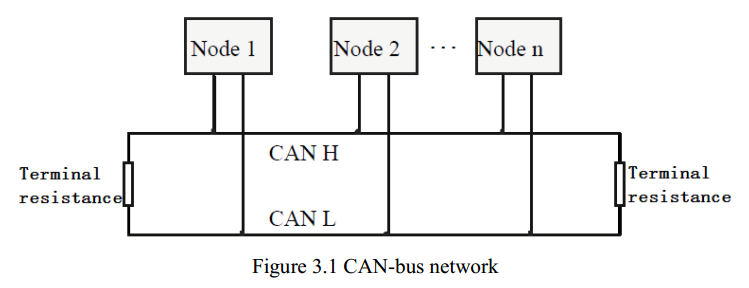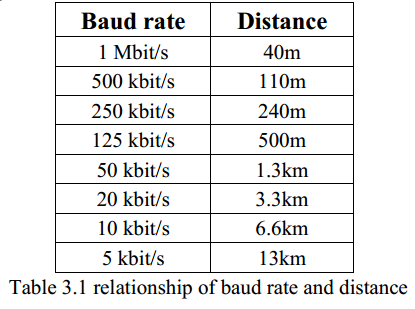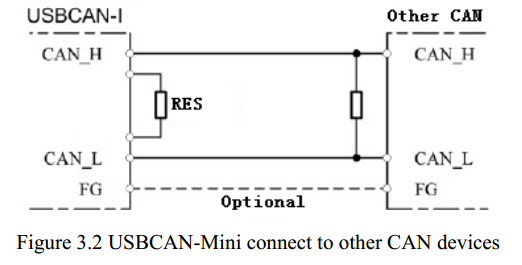Use Of The USBCAN-Mini_GCAN
3. Adapter in use
3.1 Connect to USB
USBCAN-Mini adapter can conTable to the USB2.0 full speed protocol specification,
compatible USB1.1.
When driver and software have been installed, connect the adapter to the USB interface, a new USBCAN device named "GC - Tech USBCAN Device" can be found in the PC Device manager. If there is no “!” or ”?” mark that the device run fine.
3.2 Connect to CAN
USBCAN-Mini adapter connect to CAN-Bus as chapter 2.3, CAN_H to
CAN_H,CAN_L to CAN_L.
The CAN bus network adopts topological structure, only the two furthest terminal need to connect 120Ω terminal resistance between CAN_H and CAN_L. For branch connection, its length should not be more than 3m. CAN-bus nodes connection as shown in figure 3.1
 Note: the CAN-bus cable can use twisted-pair cable, shielded twisted-pair cable. Theory of the maximum communication distance depends on the bus baud rate, Their relationship as shown in the Table 3.1
Note: the CAN-bus cable can use twisted-pair cable, shielded twisted-pair cable. Theory of the maximum communication distance depends on the bus baud rate, Their relationship as shown in the Table 3.1

3.3 CAN-Bus terminal resistance
In order to improving the communication reliability and eliminating CAN-bus terminal reflection, the two furthest terminal need to connect terminal resistance between CAN_H and CAN_L as shown in figure 3.2. Terminal resistance values determined by the characteristic impedance of the cables. Such as, the characteristic impedance is 120Ω.

Note: USBCAN-Mini adapter has none 120Ω terminal resistance inside.
3.4 System LED
USBCAN-Mini adapter with one bi-colour PWR indicator to indicate the adapter status. More functions are shown in table 3.2 and 3.3.
 When USBCAN-Mini adapter power on, the PWR indicator will light, indicates the adapter has power supply, the system is initialized; Otherwise, a system power failure or system errors has exist.
When USBCAN-Mini adapter power on, the PWR indicator will light, indicates the adapter has power supply, the system is initialized; Otherwise, a system power failure or system errors has exist.
When the adapter has been opened by software, and CAN-Bus data transceiver, the SYS indicator will blinking.

3.1 Connect to USB
USBCAN-Mini adapter can conTable to the USB2.0 full speed protocol specification,
compatible USB1.1.
When driver and software have been installed, connect the adapter to the USB interface, a new USBCAN device named "GC - Tech USBCAN Device" can be found in the PC Device manager. If there is no “!” or ”?” mark that the device run fine.
3.2 Connect to CAN
USBCAN-Mini adapter connect to CAN-Bus as chapter 2.3, CAN_H to
CAN_H,CAN_L to CAN_L.
The CAN bus network adopts topological structure, only the two furthest terminal need to connect 120Ω terminal resistance between CAN_H and CAN_L. For branch connection, its length should not be more than 3m. CAN-bus nodes connection as shown in figure 3.1


3.3 CAN-Bus terminal resistance
In order to improving the communication reliability and eliminating CAN-bus terminal reflection, the two furthest terminal need to connect terminal resistance between CAN_H and CAN_L as shown in figure 3.2. Terminal resistance values determined by the characteristic impedance of the cables. Such as, the characteristic impedance is 120Ω.

Note: USBCAN-Mini adapter has none 120Ω terminal resistance inside.
3.4 System LED
USBCAN-Mini adapter with one bi-colour PWR indicator to indicate the adapter status. More functions are shown in table 3.2 and 3.3.

When the adapter has been opened by software, and CAN-Bus data transceiver, the SYS indicator will blinking.



